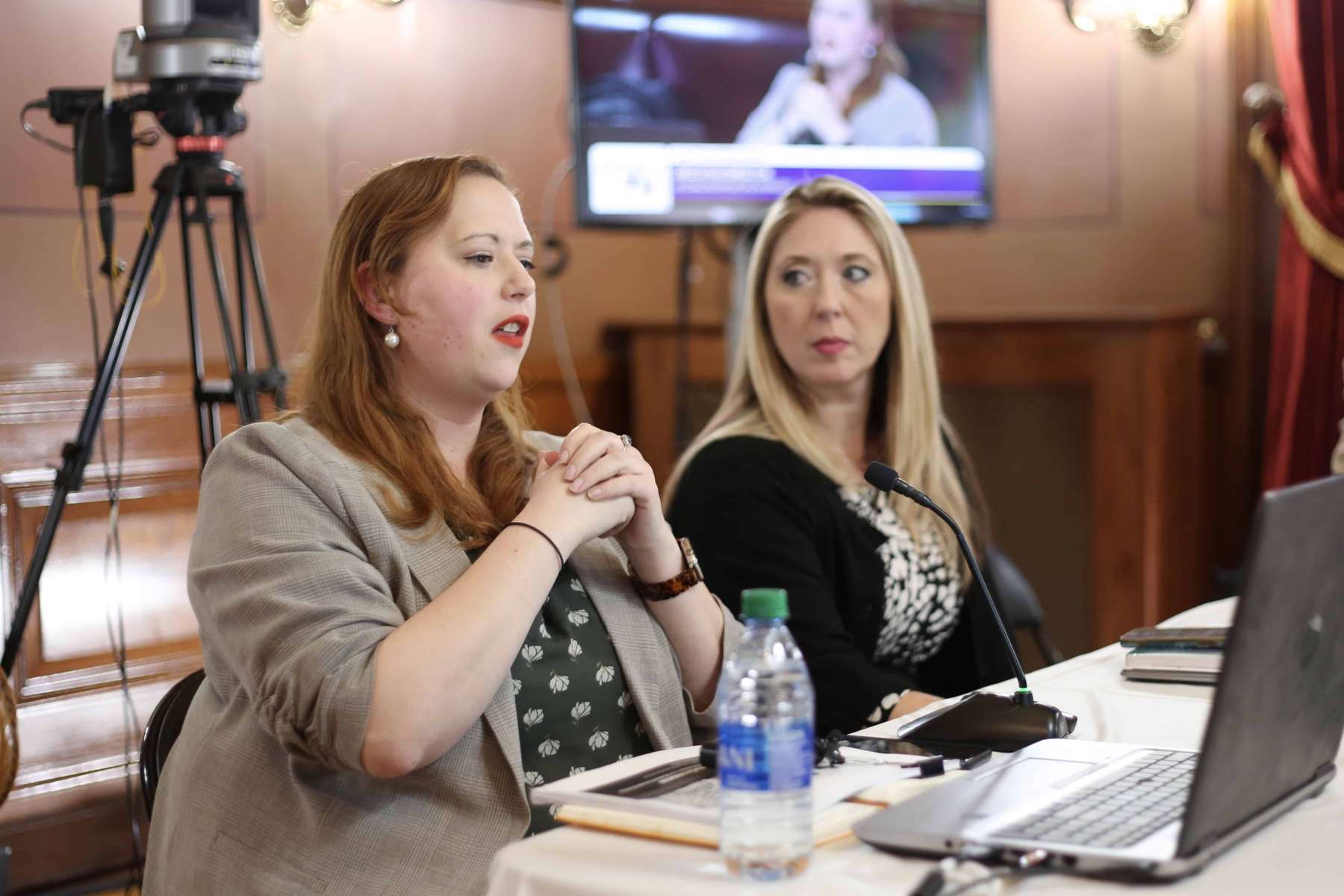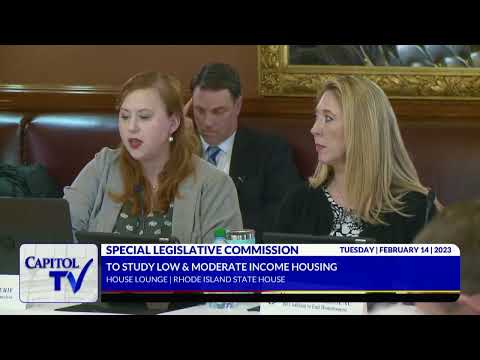Coalition addresses House committee on state of homelessness in Rhode Island
Commission members were walked through a fast and informative presentation about the extent of homelessness in Rhode Island, the inadequate efforts of the state to alleviate the issue, and what can be done about the issue going forward.
February 15, 2023, 12:37 pm
By Steve Ahlquist
The Rhode Island House Study Commission on the Low and Moderate Income Housing Act heard a presentation on Tuesday from the Rhode Island Coalition to End Homelessness on Tuesday afternoon. Executive Director Caitlin Frumerie and Deputy Director Margaux Morisseau walked through a fast and informative presentation about the extent of homelessness in Rhode Island, the state’s minimally-effective efforts to alleviate the issue, and what can be done about the issue going forward.
You can watch the video here, followed by some highlights of the presentation below.
The Economics of Homelessness
The average cost of a two-bedroom apartment in Rhode Island is $1,771, meaning that a minimum wage worker needs to work 79 hours per week to afford it. The average renter makes $18.43 an hour, but would need to make $34.06 an hour to afford that two-bedroom apartment.
But the bigger issue is that people experiencing homelessness make nowhere near enough to find an affordable apartment. The typical monthly rate a Rhode Islander experiencing homelessness can afford is $200. $200/month apartments do not exist.


The extent of homelessness
Each year Rhode Island conducts a federally mandated “Point In Time” count – a night in the winter during which volunteers and homeless advocates attempt to account for every person experiencing homelessness in the state by going out and finding them where they live – in tents, encampments, abandoned buildings, cars, warming shelters – wherever they might be sleeping.
Data from this year’s Point In Time count is still being prepared and will become available in the spring. Last year’s Point In Time count, however, is available, and advocates are not expecting any real improvements in this year’s count.
There were 1131 people living in shelters in January, 2022. There were 177 people living in “transitional housing” and 248 people living outdoors or in cars. That’s a total of 1576 people experiencing homelessness on January 26, 2022 in Rhode Island. The number is likely an undercount, and does not include people sheltered due to domestic violence, as that is tallied differently under federal law.
Caitlin Frumerie told the Commission, “Not everyone experiencing homelessness makes contact with a service provider.” As the slide below points out, “We can only account for people who have come in contact with the homeless system. Street outreach staff report seeing even more people who are outside, but aren’t connecting with the system.”
Rozann Jarosz died in Warwick earlier this year outside a TF Green Parking garage. She never made contact with homeless services.
The best estimates for this year, based on the Homeless Management Information System (HMIS), is that there are at least 1530 people experiencing homelessness in Rhode Island right now, with 375 people living “outdoors or in cars.” HMIS is the way the providers track homelessness in Rhode Island. Contrast this number with the fact that there are only 946 shelter beds available.
One of the most interesting slides was one that counters the myths around homelessness.
There are three main takeaways:
- People do not want to live outdoors. They do so because affordable housing is not available. There is a myth that there are people who want to live outside. But such people are quite rare. Wendy Thomas, a speaker with firsthand experiences in homelessness, was invited by Frumerie to talk to the commission. Thomas now works full time as an advocate for the homeless. “I have seen at least two who lived outside and liked living outside, who [later] moved into permanent supportive housing,” said Thomas. “It took time and patience. They were inside for a couple of days, they were outside for a couple of days. Four years. I know at least two who are inside all the time now.”
- When Rhode Island Governor Daniel McKee demanded to know the exact number of homeless people in the state and the exact locations of the estimated 80 encampments scattered about the state last December, he did not seem to understand the nature of homelessness. Homelessness is a moving target, a dynamic and ever-changing number. People fall in and out of homelessness. Tracking homelessness is done through the nonstop efforts of street outreach workers who meet people where they are. HMIS tracks people, not encampments. The location of encampments is sometimes known by outreach workers, but to protect the people they are serving, the location of these encampments are not routinely revealed to press, public, or the police.
- Under state law, families experiencing homelessness (with no other issues) are not abusing/neglecting their children just because they are experiencing homelessness. Many people fear losing their children to the DCYF when they are experiencing homelessness, and this fear sometimes prevents them from accessing vital services.
Shelters
A person experiencing homelessness or in fear of becoming homeless can call (401) 277-4316 for help. Information taken from that call will be entered into the Coordinated Entry System (CES) and used to assign that person appropriate shelter. This system would work well if there were shelter beds and housing available. Unfortunately, the waiting list is often long.
CES takes an average of 4,860 calls a month. As of last week, 64 families with children, 31 adult only families and 174 single adults were “living outdoors and waiting” for shelter/emergency housing.
Imagine breaking your leg, and waiting weeks for a doctor, or your house being on fire, and waiting days or months for a fire truck. Homelessness is no less severe a problem, yet the state’s response to date appears to lack the urgency required.



Another issue plaguing our response to homelessness is that people experiencing homelessness are spending longer amounts of times in shelters before being moved into permanent supportive housing. Shelters work best when people spend days or weeks there, not several months.
Who experiences homelessness in Rhode Island
As may be expected, the racial data on people experiencing homelessness is in line with prevailing, systemic racist, policies. All though Black people make up around 8.8% of the population, they represent 30.8% of the families living in emergency shelters and transitional housing.




How do we address this crisis?
The Rhode Island Coalition to End Homelessness made the following suggestions:
- Develop flexible resources to prevent and divert homelessness. Preventing homelessness before it happens is one of the best solutions. This can take the form of providing assistance to those on the brink of homelessness and helping them though issues of illness or unemployment;
- Increase the supply of crisis housing and shelter, including innovative models;
- Dramatically increase the supply of affordable housing for very low income households, including permanent supportive housing;
- Continue building a robust Department of Housing and reconvene the Interagency Council of Homelessness;
- Treat housing as healthcare to bridge the gap between health and housing stability.
After the main presentation, RI Homeless Deputy Director Margaux Morisseau outlined a series of legislative initiatives geared towards reducing the numbers of people entering homelessness and accelerating their path out of homelessness.
There were four themes in the proposed legislation:
- Create more affordable housing and remove barriers to access housing.
- Protect people who are experiencing homelessness.
- Help keep people safely housed.
- Prevent unjust practices that lead to homelessness.
Much of the legislation is in development and has not had a bill number assigned. The ideas include:
- Doing away with rental application fees. Many out-of-state corporate landlords charge fees, even for apartments they do not plan to rent, collecting fees from struggling renters;
- With the Lieutenant Governor’s office, the Coalition is working to revise Fair Chance Housing legislation, which did not pass the General Assembly last year. The bill, based on Providence Housing Authority best practices, creates a shorter look-back time on police records when people are looking for housing, gives prospective tenants the right to appeal, and limits the kinds of crimes that can affect housing applications.
- Code Red or Code Blue supplies parameters for when there should be a state of emergency for hot and freezing temperatures. Based on a New Jersey law, the legislation would give the Rhode Island Emergency Management Agency guidance on how their federal dollars should be invested in cities and towns. It would, for instance, disallow federal dollars to be used for warming centers that are not open 24 hours, like libraries.
- $5 million in funding for a “Housing Problem Solving Fund.” This would be different from and not replacing emergency rental funds, which are also needed.
- The right to council for evictions. Most people being evicted do not have access to a lawyer. Landlords, on the other hand, almost always do. This power differential in eviction court needs to be addressed.
- PayDay Lending reform. Payday loans are predatory loans given at 260% APR. They are outlawed in every New England state except Rhode Island, and also outlawed nationally on or near military bases.
- Fair notice. When a landlord proposes any increase in rent they would have to give 120 days notice to the renter.
Next week do not miss our exclusive interview with Stefan Pryor, the new Secretary of Housing under Governor McKee.







